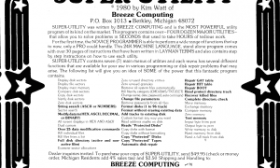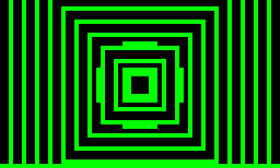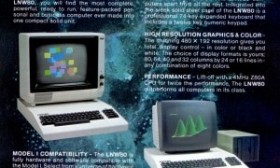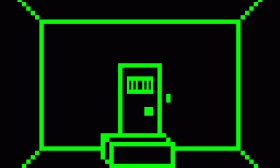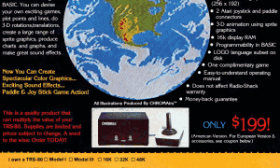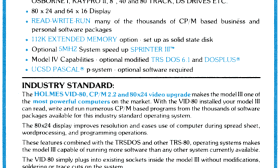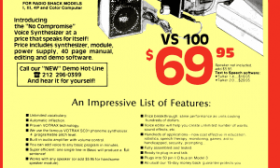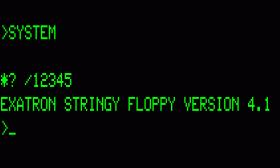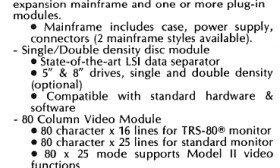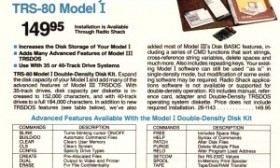I suspect that almost everyone who used a TRS-80 disk system remembers Super Utility. First released by Kim Watt in 1980 through his company Breeze Computing, Super Utility was regarded by many to be an indispensible tool. It was described in advertisements as “The King of Utilities” and readers of 80 Micro must have agreed; they voted it 1st Place in the utility category for both the 1982 and 1983 Readers' Choice Awards. According to one source, a copy of Super Utility was a required purchase for all United States government offices with a TRS-80.
In all, there were versions of Super Utility for the TRS-80 Model I, III, and 4, the Lobo MAX-80, and the IBM PC. I think William D. Allen said it well in a 1983 review in 80 Micro:
This program is like a fire engine. You don’t need it every day, but when you do nothing else will do the job.
(Read more...)
Cosmic Patrol was a TRS-80 game written by Jake Commander, probably better known for his “Commander 80” column in 80 Micro. It was published by Wayne Green’s software company, Instant Software, costing $14.95 for a tape version and $19.95 for a disk version.
Cosmic Patrol appears to have been based on Cosmic Conflict!, a 1978 game written for the Magnavox Odyssey 2 home video game system. The goal is simple: destroy 15 vessels in the Quelon fleet before running out of E-units. Each game begins with 999 E-units. Each shot fired, whether it hits anything or not, costs ten E units.
(Read more...)
The LNW80, sometimes referred to as the LNW80 Model 1, was the first in a line of TRS-80 compatible computers sold by LNW Research Corporation (later known as LNW Computers). It was probably the most successful TRS-80 compatible sold in the United States. LNW Research had already created the LNW System Expansion, a replacement for the Radio Shack Expansion Interface, so the LNW80 was in many ways a natural next step.
When the LNW80 was introduced in 1980 it was originally sold as a $89.95 “semi-kit,” with instructions and bare printed circuit board. The semi-kit price was so low because all of the electronic parts required for the kit had to be purchased separately. Careful shopping could help reduce costs, but the complete inventory of parts cost hundreds of dollars.
Despite the name, the LNW80 “semi-kit” was not a project for beginners; according to Dennis Báthory-Kitsz in his “80 Applications” column in 80 Micro there were 1,800 individual solder connections. For customers who wanted a complete computer, the LNW80 could also be purchased fully assembled, along with the LNW System Expansion, for $1450.00.
(Read more...)
Asylum was the third game in the “Continuum series” of 3-D graphics adventures sold by Med Systems Software. It was preceded by Deathmaze 5000 and Labyrinth and followed by Asylum II. In early 1983, Med Systems Software changed its name to ScreenPlay (which was itself a division of Intelligent Statements, Inc) but continue to sell Asylum.
Med Systems Software sold Asylum for the TRS-80 in both cassette and disk versions. The cassette version came in both 16K and 32K version. The 16K version contains the same puzzles, but the descriptive messages are shorter and the parser recognizes fewer words.
In addition to the TRS-80 version, Med Systems sold cassette and disk versions of Asylum for the Apple II and an IBM PC version written by David C. Willen for Computer Applications Unlimited. Confusingly, the versions they released as Asylum in 1984 and 1985 for the Commodore 64, Atari 400/800, and IBM PC were not adaptations of the TRS-80 version of Asylum. They were actually adaptations of the TRS-80 version of Asylum II
(Read more...)
The CHROMAtrs was a TRS-80 Model I and III add-on that could display color text and graphics on a separate monitor or television. The CHROMAtrs had advanced graphics and sound features, but using those features required low-level programming that was beyond the abilities of many people. That all changed with the introduction of CHROMA BASIC.
CHROMA BASIC was written by Robert French, who was 14 years old at the time. It added over 68 commands to BASIC to manipulate the graphics, sound, and joystick features of the CHROMAtrs. Although originally priced at $30.00, CHROMA BASIC was soon bundled with the CHROMAtrs package and prominently featured in the advertisements.
(Read more...)
The Holmes VID-80 was a popular add-on for the TRS-80 Model I and III. Introduced by Holmes Engineering, Inc. in 1982, the VID-80 offered two related features:
- It expanded the TRS-80 screen from 64 characters wide by 16 characters high to the larger 80 characters wide by 24 characters wide.
- It changed the TRS-80 memory map to allow running the CP/M operating system.
(Read more...)
The Alpha Products VS-100 was a popular voice synthesizer for the TRS-80, selling thousand of units. Introduced in 1983 by Alpha Products for a price of $69.95, the VS-100 was available for the TRS-80 Model I, Model III, Model 4, and also the Color Computer. Alpha Products lowered the price of the VS-100 several times; it was reduced to $49.95 in 1985 and $24.95 in 1987.
The VS-100 was a 3″ by 5″ unit that connected to the expansion port of the Model I, Model III, or Model 4. It came with a power adapter, but not the required external speaker. Alpha Products sold a “handsome speaker module” separately for $5.95.
(Read more...)
I recently added emulation of the Exatron Stringy Floppy to my TRS-80 emulator for Windows. This has created some new interest in the Stringy Floppy, a storage device which was a popular add-on for the TRS-80 back in the early 1980’s.
The Stringy Floppy is one of those items that many people remember, but they remain a little fuzzy on the details. Here is more information about the commands used on the Stringy Floppy.
(Read more...)
The Holmes Expansion Mainframe was a popular alternative to the Radio Shack Expansion Interface for the TRS-80 Model I. Introduced in mid-1982, the Expansion Mainframe offered expansion options in a different manner than its competition. It provided extra features through the installation of special plug-in modules, also sold by Holmes Engineering. In addition to supporting the Model I, the Expansion Mainframe was also described as being compatible with the PMC-80 when used with the PMC to TRS-80 adapter sold by Personal Micro Computers.
The Expansion Mainframe was known as a very reliable unit, with gold-plated connectors and all data lines fully buffered. For maximum reliability, Holmes Engineering also recommended gold-plating the connector on the Model I itself using a product such as Gold Plug 80. The Expansion Mainframe was often paired with two earlier Holmes Engineering products, the SPRINTER speed-up board and the Internal Memory memory expansion.
The Expansion Mainframe was housed in an off-white metal enclosure, measuring 16 1/2″ by 9 1/8″ by 2 7/8″, which also served as a base for the Model I monitor. It came in two versions:
(Read more...)
The original TRS-80 Model I, when paired with a Radio Shack Expansion Interface, was only capable of single-density floppy disk access. This limitation was addressed by the Percom Doubler, introduced in 1980, which modified the Expansion Interface to add double-density. The Percom Doubler soon became the de-facto standard for double-density interfaces on the Model I. Almost all companies that created double-density add-ons made them compatible with the Percom Doubler.
The Radio Shack Double-Density Disk Kit (catalog number 26-1143) was Radio Shack’s own double-density add-on for the Model I. Introduced on May 1, 1982 (nearly one and a half years after the Model I was discontinued), the Double-Density Disk Kit cost $149.95, not including installation. Despite the official name, many people referred to it as the Radio Shack Doubler.
Like the Percom Doubler, the Double-Density Disk Kit installed inside the Radio Shack Expansion Interface. It was described this way in the catalog:
(Read more...)
